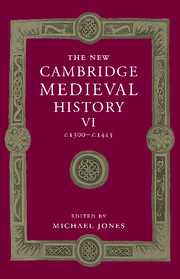Book contents
- Frontmatter
- Part I General Themes
- 1 Introduction
- 2 The Theory and Practice of Government in Western Europe in the Fourteenth Century
- 3 Currents of Religious Thought and Expression
- 4 The Universities
- 5 Rural Society
- 6 Urban Life
- 7 Plague and Family Life
- 8 Trade in Fourteenth-Century Europe
- 9 Chivalry and the Aristocracy
- 10 Court Patronage and International Gothic
- 11 Architecture
- 12 Literature in Italian, French and English: Uses and Muses of the Vernacular
- Part II The States of the West
- Part III The Church and Politics
- Part IV Northern and Eastern Europe
- Appendix Genealogical Tables
- Primary Sources and Secondary Works Arranged by Chapter
- Index
- Frontispiece
- Plate section
- Map 4 Europe's trade, c. 1300
- Map 5 Europe's trade, c. 1400
- Map 7 The Hundred Years War to 1360
- Map 15 Russia, c. 1396
- Map 17 The Byzantine empire in the 1340s
- References
11 - Architecture
from Part I - General Themes
Published online by Cambridge University Press: 28 March 2008
- Frontmatter
- Part I General Themes
- 1 Introduction
- 2 The Theory and Practice of Government in Western Europe in the Fourteenth Century
- 3 Currents of Religious Thought and Expression
- 4 The Universities
- 5 Rural Society
- 6 Urban Life
- 7 Plague and Family Life
- 8 Trade in Fourteenth-Century Europe
- 9 Chivalry and the Aristocracy
- 10 Court Patronage and International Gothic
- 11 Architecture
- 12 Literature in Italian, French and English: Uses and Muses of the Vernacular
- Part II The States of the West
- Part III The Church and Politics
- Part IV Northern and Eastern Europe
- Appendix Genealogical Tables
- Primary Sources and Secondary Works Arranged by Chapter
- Index
- Frontispiece
- Plate section
- Map 4 Europe's trade, c. 1300
- Map 5 Europe's trade, c. 1400
- Map 7 The Hundred Years War to 1360
- Map 15 Russia, c. 1396
- Map 17 The Byzantine empire in the 1340s
- References
Summary
the fourteenth century saw the triumphant expansion of Gothic architecture from a largely French into a wholly European phenomenon. Gothic became the dominant visual language of Christendom, and in the process underwent a transformation of almost everything that it had meant in the first century of its life. Conceived as the theological and liturgical handmaiden of a small and homogeneous circle of European higher clergy, it now emerged, revitalised but fragmented, as the architecture of a socially diverse patronage, much of it lay rather than ecclesiastical. In the hands of kings, princes, the higher nobility, a prosperous bourgeoisie and the ‘popular’ orders of the friars, Gothic proliferated into new, more secular, genres, promoted in part by the expectations of this new clientèle. If the ‘great church’ – the basilican cathedral and monastic church – dominated the first one hundred years of Gothic, the chapel, the castle-palace, the city and its public buildings were now, for the first time, recognized as the principal architectural challenges of the later Middle Ages. In turn, these new classes of patron altered the geography of medieval art. The architectural hegemony enjoyed by Paris and northern France in the twelfth and thirteenth centuries came to be disputed by centres of patronage hitherto on the fringes of the Gothic world – Naples, Florence, Cologne, London, Barcelona, Prague and Marienburg – many of them new capitals of lay government. Such shifts in the balance of artistic power had profound consequences for the history of architectural style.
- Type
- Chapter
- Information
- The New Cambridge Medieval History , pp. 234 - 256Publisher: Cambridge University PressPrint publication year: 2000
References
- 1
- Cited by



